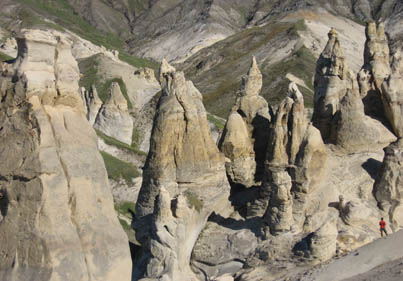Notes from the Field: Rocks and ice
Notes from the Field: Rocks and ice McGill University
User Tools (skip):
NOTES FROM THE FIELD
Rocks and ice
Searching for fossils in the Canadian High Arctic

What were once beach sands are now impressive spires of rock called hoodoos on Bylot Island, Nunavut with Hans Larsson for scale.
LUKE HARRISON
God it's beautiful here.
I'm standing on Bylot Island, looking out over a sea of ice dotted by patches of open water and the occasional seal. In the distance, if you know where to look, you can barely make out Pond Inlet, a community of around 1,300 and the hub for researchers in this part of the Arctic. It's lunch time and we are sitting down to a meal of loganberry bread (imagine Christmas fruit cake minus the rum and left in the oven overnight), beef jerky, cheese, and garlic sausage while trying to get out of the wind. The temperature is comfortable, around 5-10 Celcius, its cool enough to need your Gore-Tex but not your sweater. I keep scanning the shoreline for signs of polar bears (there aren't any) and watching the occasional gull gliding effortlessly over a sea of white. I'm here as part of a team led by my supervisor, Dr Hans Larsson, and Natalia Rybcznski of the Canadian Museum of Nature, but we aren't here just to enjoy the view. We're here to uncover passages from an untold story of the Canadian Arctic.
Bylot wasn't always a place of wind and ice. During the Late Cretaceous period (around 70 million years ago) it was a much warmer and wetter place, more like modern Florida. It was bordered by a shallow sea that stretched down to the Gulf of Mexico. In this sea swam scores of fish, sharks, ammonites (armored relatives of the squid) and a diverse assemblage of marine reptiles including crocodiles, giant turtles and plesiosaurs (picture Nessie of Loch Ness fame). At this time herds of hadrosaurs (large herbivorous dinosaurs) would roam the land much like caribou do today, with tyrannosaurs playing the role of the wolves. Here they lived, and here they died, and sometimes their bodies were buried and became fossilized. That's why we're here.
Besides Hans, Natalia and myself, the team consists of two of my lab mates (Maria de Boef and Luke Harrison), Liz Ross (an undergrad from Ottawa) and Laura Wilson from Colorado, our token American. We are prospecting a loosely consolidated sandstone hill called Sharktooth Ridge (no prizes for guessing what the most common fossil is) that was once a beach front 70 million years ago. These near-shore deposits preserve not only marine organisms, but also terrestrial creatures washed out to sea, thus giving us a chance to get a snapshot of the entire ecosystem. We've chosen this site to prospect because it is so rich in fossils that you can hardly take five steps without finding something. We're trying to get a clearer picture of the faunal composition of Bylot Island all those millions of years ago. It is like doing a census by randomly picking names out of a hat. To even approximate the true ecosystem we need a large data set, and that means hours of slowly walking (and occasionally crawling) across the sand, searching for the tell-tale texture of bone or the outline of a tooth, amid the rubble.
We finish lunch and spread out. Hans takes off for the farthest edge of the hill (won't even try to follow him, he can do this at a clip that you have to jog to keep up with). Maria, Laura and Natalia disappear somewhere on the upper ridge. Liz heads off towards the right. I stay left, falling in near Luke, giving me someone to talk to. Luke has both a good eye and lots of luck (both crucial to finding fossils), so maybe some of it will rub off on me.
In addition to the thrill of discovery, prospecting has a Zen-like quality, whereby you are both focused and not at the same time. As you spend hours intensely scanning the ground for signs of a fossil, your mind can wander. Yet all it takes is a tiny fragment of bone or a tooth to refocus your attention. As I walk, I try to imagine what it must have been like here when these sands were just dunes on a beach, but it's hard. The world these creatures inhabited is vastly different from the one I'm wandering in now, with a sub-tropical forest where now there is only permafrost. So I go back to singing the Tragically Hip's "Another Midnight" in my head and move in closer on a rock which has caught my interest. Is it bone? Wood? Maybe a tooth fragment? No, it's just a rock. I toss it back and head off following a dried up stream-bed downhill. There is still much work to do, but we're beginning to get a sense of this island's untold story.
T. Alexander Dececchi is in his first year of his PhD. continuing the work he started as a master's student in Dr Hans Larsson's lab at the Redpath Museum. The project is funded by the Northern Scientific Training Program and the Polar Continental Shelf Program. This was Dececchi's second year up in the High Arctic, and hopefully not his last.

